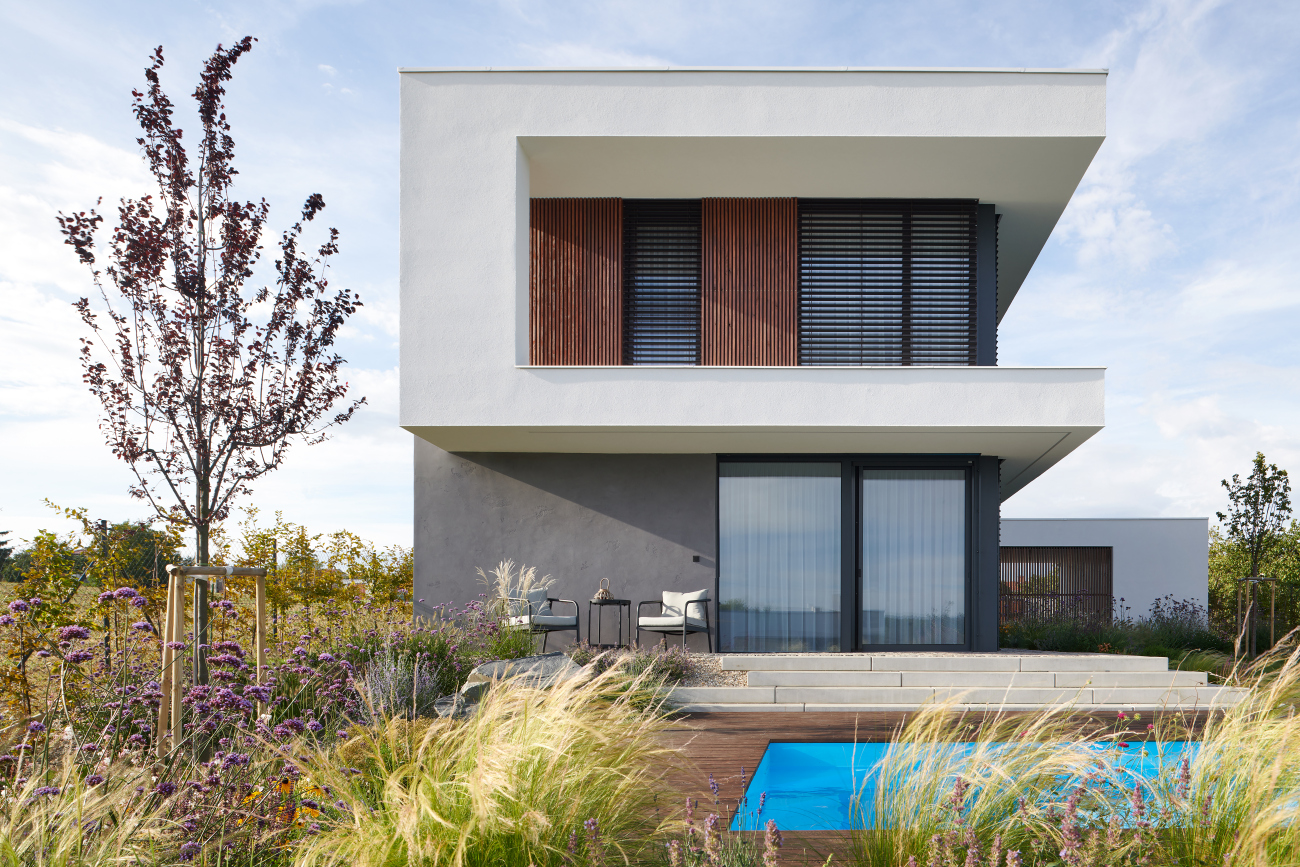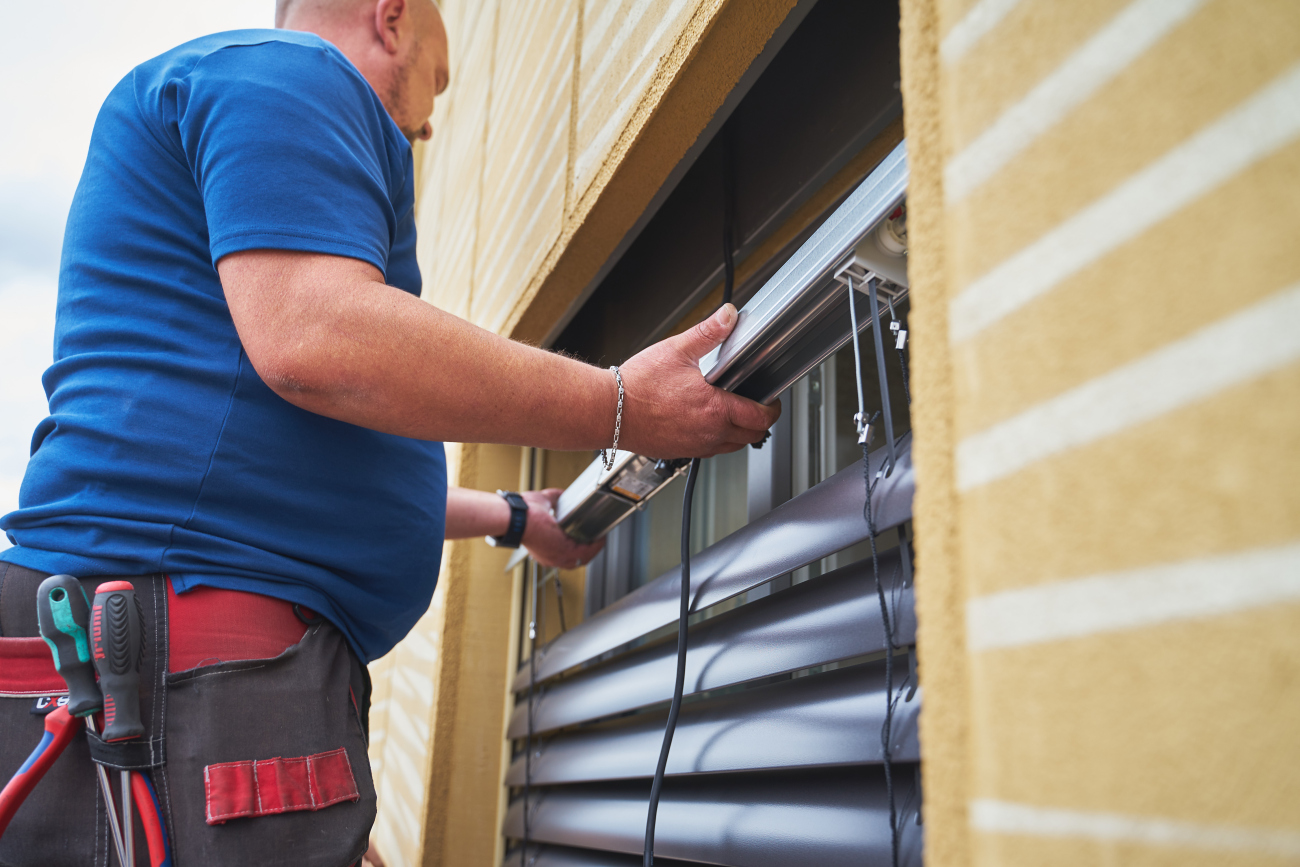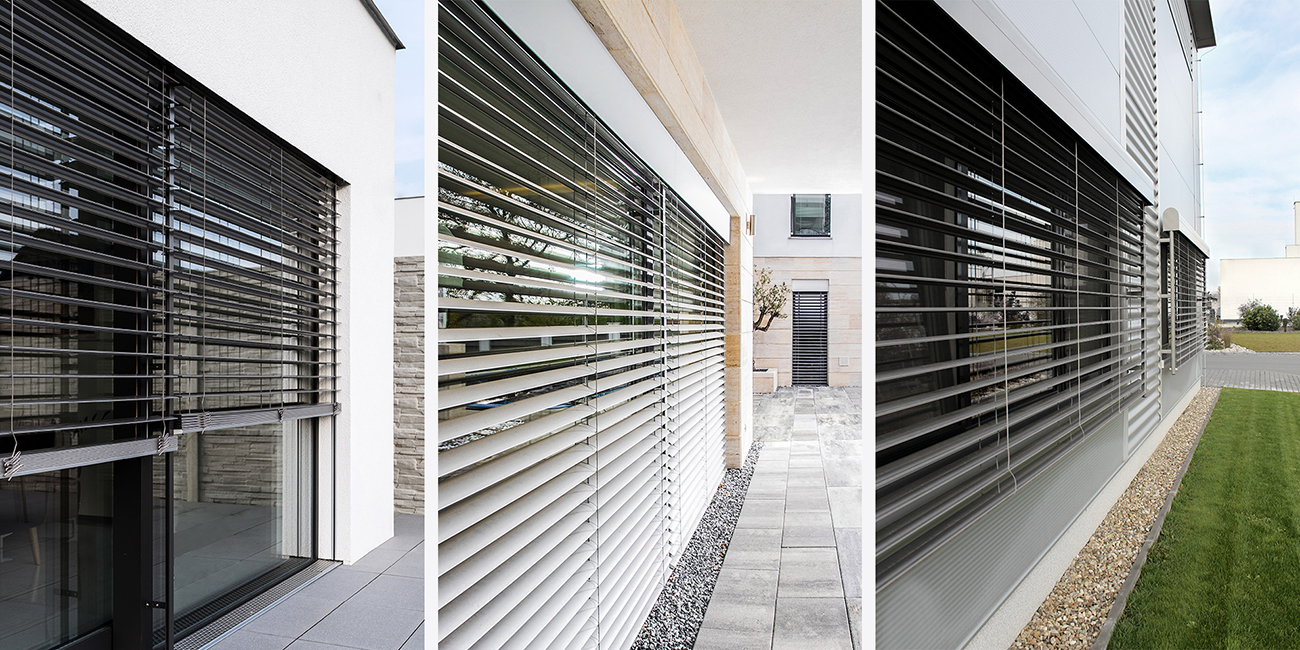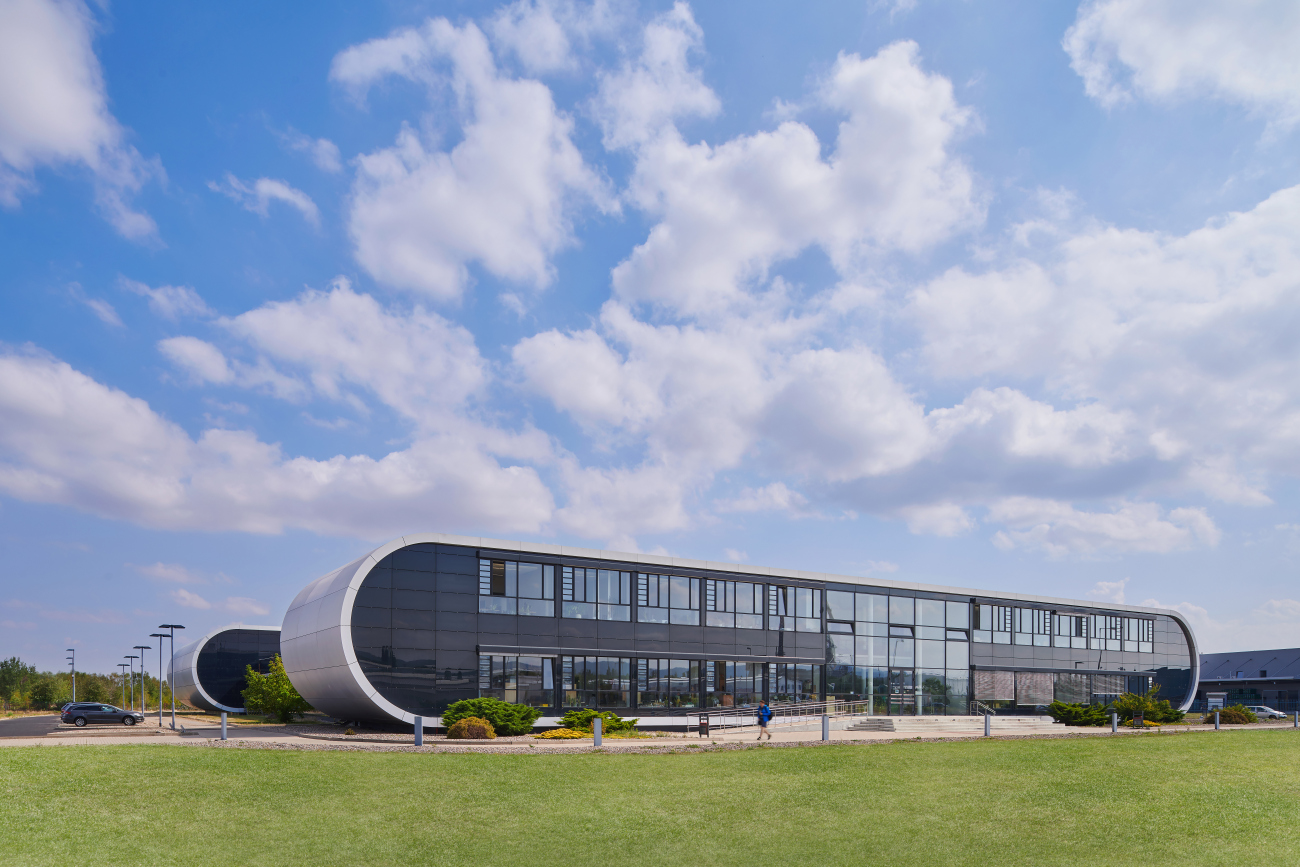
How does the method of installing outdoor blinds influence the appearance of the house?
The method of installation of outdoor blinds affects how pronounced an architectural element the shading will create on the house. Blinds can be installed discreetly under the facade, under a cover panel, or clearly in front of the facade. Read on to find out when each solution is appropriate and why.
You have three installation options for outdoor blinds:
The cover into which the blinds retract is placed in a prepared space in the facade above the window, and all anchoring and the upper profile of the blinds are hidden under the plaster. If you want absolutely nothing to disrupt the exterior of the building, the guiding profiles of the blinds can also be hidden under the plaster. This is achieved with a special cover ISO-KASTL supplemented with sandwich panels, which allow the profiles to be recessed into the facade.
However, you need to include the hidden installation in the project, so that the building can be prepared in time for the installation of the blinds. "Installation under the facade has proven to be the best for us because the anchoring elements are hidden and do not disrupt the architecture of the house. We prepare the house for such a solution in the project documentation so that the building is ready for the installation of built-in boxes," explains architect Tomáš Lánský from Brossini Design.
The anchoring of the blinds is not as discreet as with the hidden installation under the facade, but it does not stand out significantly either.
The painted panel is installed on the window frame or into the construction opening, and all anchoring elements are recessed into the reveal or anchored to the window frame. Moreover, you can choose a color for the cover panel to match the house or make it as inconspicuous as possible.
The only downside is that the cover reduces the clear height of the window and partially obstructs the homeowners' view.
This method of installation is the most pronounced, as the box with anchoring protrudes from the plaster and is a robust element on the facade of the house. It is therefore more suitable for technical buildings where more massive elements on the facade are not a problem.
You can then adapt the facade system to the style of the building – for example, NEVA can produce facade systems in both round and square variants, so you can choose the one that matches the style of the house better.
"We choose the protruding system in front of the facade only in the case of renovations when intervention in the building's lintel is not possible – a visible box would disrupt the appearance of the house, so we try to avoid it if possible," adds architect Lánský.
Whichever installation method you choose, always include outdoor blinds in the project. "This way, you can avoid later unpleasantness with unresolved details on the construction. Additionally, the homeowner can then apply for a subsidy for the shading," advises Jan Gajdoš, an outdoor blinds specialist from NEVA.
If you have any questions regarding outdoor shading, schedule a consultation directly with the specialists at NEVA – just write an email to [email protected].
 |
You have three installation options for outdoor blinds:
1. Hidden installation under the facade minimally disrupts the appearance of the house
The Czech manufacturer of outdoor shading NEVA recommends choosing installation under the facade whenever possible - mostly in the case of new buildings or during a general reconstruction when you don't have to consider the condition of the building. Hidden installation under the facade is the most practical from an architectural perspective, as it least disrupts the appearance of the house.The cover into which the blinds retract is placed in a prepared space in the facade above the window, and all anchoring and the upper profile of the blinds are hidden under the plaster. If you want absolutely nothing to disrupt the exterior of the building, the guiding profiles of the blinds can also be hidden under the plaster. This is achieved with a special cover ISO-KASTL supplemented with sandwich panels, which allow the profiles to be recessed into the facade.
However, you need to include the hidden installation in the project, so that the building can be prepared in time for the installation of the blinds. "Installation under the facade has proven to be the best for us because the anchoring elements are hidden and do not disrupt the architecture of the house. We prepare the house for such a solution in the project documentation so that the building is ready for the installation of built-in boxes," explains architect Tomáš Lánský from Brossini Design.
 |
| If you opt for hidden installation of blinds under the facade, the installers will place a cover in the prepared space above the window into which the blinds will retract, hiding all anchoring under the plaster. |
2. Installation under a cover panel is visible
If you are responsible for a partial reconstruction of a client’s house and installation under the facade is not an option, the ideal solution is retrofit installation of outdoor blinds under a cover panel.The anchoring of the blinds is not as discreet as with the hidden installation under the facade, but it does not stand out significantly either.
The painted panel is installed on the window frame or into the construction opening, and all anchoring elements are recessed into the reveal or anchored to the window frame. Moreover, you can choose a color for the cover panel to match the house or make it as inconspicuous as possible.
The only downside is that the cover reduces the clear height of the window and partially obstructs the homeowners' view.
 |
| Types of installation of outdoor blinds: (from left) under the facade, under the cover panel, and the protruding variant. |
3. Protruding installation in front of the facade creates a pronounced element
If the state of the building does not allow for anchoring the blinds under the facade or a cover panel, installation on the facade remains. All anchoring elements are placed from the front onto the house, and the blinds are protruded in front of the window opening.This method of installation is the most pronounced, as the box with anchoring protrudes from the plaster and is a robust element on the facade of the house. It is therefore more suitable for technical buildings where more massive elements on the facade are not a problem.
You can then adapt the facade system to the style of the building – for example, NEVA can produce facade systems in both round and square variants, so you can choose the one that matches the style of the house better.
"We choose the protruding system in front of the facade only in the case of renovations when intervention in the building's lintel is not possible – a visible box would disrupt the appearance of the house, so we try to avoid it if possible," adds architect Lánský.
 |
| Robust protruding blinds are suitable for more technical buildings. |
Whichever installation method you choose, always include outdoor blinds in the project. "This way, you can avoid later unpleasantness with unresolved details on the construction. Additionally, the homeowner can then apply for a subsidy for the shading," advises Jan Gajdoš, an outdoor blinds specialist from NEVA.
If you have any questions regarding outdoor shading, schedule a consultation directly with the specialists at NEVA – just write an email to [email protected].
The English translation is powered by AI tool. Switch to Czech to view the original text source.
0 comments
add comment
Related articles
0
01.08.2024 | Elegance same: the Czech manufacturer of exterior shading NEVA has launched a recessed screen roller shutter
0
01.11.2021 | How to best cover or shade a terrace
1
20.10.2021 | Screen roller blinds: where do they fit best and why?
0
13.02.2021 | How to design a well-cooled house even without air conditioning
0
19.11.2020 | In Malmö, a new hospital complex has been inaugurated. It considers the health of patients as well as the environment
0
02.11.2020 | Aluminum vs. wooden outdoor blinds: aluminum is more durable, while wood feels warmer
0
12.10.2020 | How do the world's sides affect the layout design of an apartment?
0
04.08.2020 | Z, S or C? How to choose the shape of the slat for outdoor blinds according to the type of house or window
0
01.07.2020 | What color for outdoor blinds? Lighter shades are more practical
0
25.05.2020 | Expert advises: how to overshadow architecturally exceptional buildings
0
24.04.2020 | In the selection of blinds, the material of the facade, the shape of the house, and the connection with the interior are decisive, says architect Lánský
0
25.03.2020 | In the shadowing market, outdoor blinds dominate. The most popular are silver ones.











